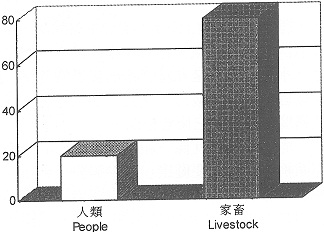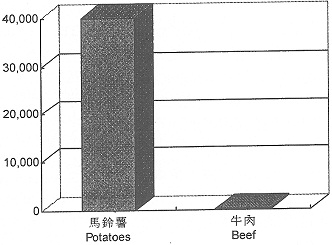|
一天三餐,對我們來說是一件很平常且理所當然的事。但是在許多開發中的國家來說,一天能吃一餐就已經很好了。世界上,每2.3秒就有一個小孩因營養不良而死;每一天,有24,000的人因飢餓而死亡。世界的各個角落,都有人在飢餓的陰影下度過;其中的主因,就是缺水。所以節約水源,來提高食物生產量,就是減少飢餓人口的最佳辦法。
地球上大部分的水,都是海裡面的鹹水,淡水只佔了全球水源的3%;而在那3%裡,2%的水在南北極的冰河或高山上的冰川裡。 |
|
Breakfast, lunch, and dinner are the three basic meals we have every day, and we take them for granted. In many third-world countries, one meal a day is already good enough. Every 2.3 seconds, a child dies as a result of malnutrition, and 24,000 people die from hunger each day. Scarcity of water is the main reason for this worldwide hunger. Therefore, saving clean water to increase food production is the primary way to stop world hunger.
Almost all the water on the planet occurs as saltwater in the oceans. Freshwater constitutes only 3% of the global water resource with over 2% of it frozen in glaciers of polar or mountainous regions. Hence, only less than 1% of the water resource is liquid freshwater. Practically all the freshwater occurs as groundwater. Groundwater is a highly useful and abundant resource, but it takes thousands of years to replenish. If groundwater is extracted too intensively, it will become depleted.
|
|
所以事實上只有低於1%的水源,是液態淡水;實際上,絕大部分的淡水,都是地下水。地下水是非常有用而寶貴的資源,要經過幾千年的歲月,才會再形成;如果我們過度的抽取,它便會枯竭。
地球,其實就像一顆水球,我們的生活都圍繞著水;你要健康,至少需要一天喝一杯水。想要你的花園、菜園生意盎然,你必須用愛心護園,用適量水來澆園。照顧花園、菜園後,你一定想去沖個涼,把汗沖洗掉,或是泡個澡,以驅除疲勞。那一堆髒衣服怎麼辦?你得用洗衣精和水來洗。在美國,每人每天約用掉190至380加崙的水(不包括灌溉、澆水),而我們的家用水,98%來自於地下水。
那麼農業用水在灌溉上,目前佔了全球水源的百分之七十,到底幾加崙的水是用在家畜及農產物上呢?要60加崙的水灌溉,才能生產一磅的馬鈴薯,但是要1,849加崙的水,才生產一百公克(0.22 磅)的牛肉而已。所以要一磅的牛肉必須用8,495加崙的水。
牛肉產業,為能自己站得住腳,全面支持了一項高度可疑的數學研究。該研究表示:事實上,只需441加崙的水來生產一磅的牛肉。其論證理由如下:
1.水在製作過程中,因達到某種沸點而蒸發了。
2.水在被用來種植餵食的植物後,又「回到」了地下之水位。
3.水經由牛的便尿,而「回到」了地下之水位。
牛肉工廠辯論說這些水是被運用的,不是「流失了」,而是「回收了」;因此這些水,可以從原本計算生產一磅牛肉的總水量扣除。當然,蒸發和牛糞根本沒辦法真正替代經千百年的歲月而形成的地下水。如果用牛肉業的算術程式來計算,一磅馬鈴薯,只有用2加侖水而已。
引最暢銷書的作家兼素食主義領導者──約翰‧羅賓斯之言:「把我們珍貴的資源揮霍在生產肉類這樣的奢侈品上,實在是浪費和不負責任。」對開發中的國家來說,用掉的淡水中,農業用途佔70%到90%之多。斯德歌爾摩「國際水資源協會」的資深科學家馬林.法肯馬克說,以一般美國家庭而言,一個以肉食為主的飲食,年耗水量是320,000加侖;而以素食為主的飲食,年耗水量約4,745加侖,兩者相差約70倍。雖然這並沒有在美國主要報紙上報導,但有一項瑞士的研究證明「以一典型美國人飲食之標準,生產一人的食物所需之水,足夠養活以蔬菜為主、更健康的32位之飲食。」
右為肉及蔬菜食物生產的一些比較圖:
那到底怎麼減少生產食物的水呢?很簡單,只要成為一個奶蛋素者或不吃肉、不吃乳製品的純素食者即可。成為一個奶蛋素者,能把原本一年用在生產食物的320,000加崙水,降低至大約10,000加崙。不只是這樣,只要美國人少吃百分之十的肉,一億人民便可靠所空出的土地而得以飽食。
只有乾淨的水是可用的,我們不只要節約水源,也須要避免污染水。許多節約水源的點子,可行之於家中室內。
A)換個水龍頭的橡皮圈,就可修補家中會滴水的水龍頭。假如水龍頭一秒漏一滴,一年下來,就浪費了10,220公升(大約 2,700加崙),這樣還會增加自來水與廢水處理的費用。
B)只有在滿檔的時候,才啟用洗碗機和洗衣機,並應量調整適當的水位。進一步節約能源的方法是:如果天氣允許,利用戶外曬衣線(竿),來曬衣服。
C)縮短洗澡時間。洗十分鐘的澡,用掉190公升的水;但如果把時間縮短成五分鐘,你就省了95公升的水。在每一間浴室裡,擺一個桶子,接住還沒有轉換成熱水的冷水。你每次沖澡,就會接了大概七或八公升的冷水;這幾桶冷水,可以用來清潔或澆花草。還有,洗臉或刮鬍子時,不要一直開著水;在等水變熱之間,可先刷牙;然後把洗臉盆的水裝滿,再洗臉或刮鬍子。
D)加食用顏料滴到馬桶的水箱,可檢查馬桶是否有裂縫。如有裂縫,不到三十分鐘,馬桶裏就會出現了顏色。檢查馬桶是否有磨損、腐蝕或扭曲的零件;檢查完,立即把水沖掉,因為食用顏料可能會在水箱留下污痕。
E)廚房的垃圾除餘機需要用很多水,才能正常運用。使用堆肥的餿水桶來代替,這亦可避免製造更多固體垃圾。垃圾除餘機也能在化腐箱裏,增加50%的固體容量,導致故障與維修等問題。
教育大眾水對於飢饉以及食物生產的重要性,是另一個幫助的好方法。引發孩子保護用水的警覺性,因為兒童是地球的未來希望;另外,盡量不要買須要持續用水的消遣性玩具給孩子。鼓勵你的老闆在工作場所提倡節約水源,建議在新進員工訓練手冊和員工訓練程序中,加入節約水源這一項,並且支持呼籲節約水源的公司。鼓勵你的朋友和鄰居,一起參加節約水源的活動。
當你在旅館,或是任何沒有個人付水費的地方,切勿因為水是別人付而浪費。哪怕節省一點點水,那對地球有限的水量,還是有幫助的。而且每個人都可以改變世界,請記住:「一隻蝴蝶拍拍翅膀,會造成地球的另一端括起龍捲風」。每3.6秒,就有一個人因飢餓而喪失生命;因此,為了挽救生命,我們就需要節約水源。
|
|
Our Earth indeed is a water planet, and our life revolves around it. At least a cup of water a day is needed for you to stay healthy. For your gardens to stay healthy, you need to tend the gardens with care and the right amount of water. After tending the garden, you most likely need to take a shower to wash away your sweat, or to bathe in the bathtub to relieve your fatigue. What do you do with your loads of dirty clothes? You wash them with detergent and water. Around 190~380 liters of water are used daily by each person in the United States, and 98% of the water we use at home comes from aquifers.
Agricultural irrigation presently accounts for 70% of all water withdrawals worldwide. How many gallons of water are used for livestock and agriculture? It takes 60 gallons of water to produce one pound of potatoes, while 1,849 gallons are used to produce just a hundred grams (0.22 pounds) of beef. Therefore, 8,495 gallons of water is needed to produce one pound of beef.
The beef industry did a highly specious study to try to counteract this fact. That study determined that only 441 gallons of water were required to produce a pound of beef. They backed up their calculations with the following reasons:
1. Water evaporated at certain points during the process.
2. Water was “returned” to the water table after being used to grow plant feed.
3. Water was “returned” to the water table by the means of urea and excrement from cows.
They argued that this water was used, not “lost” but rather “recycled” and so therefore could be subtracted from the total amount of water actually used in beef production. Of course, evaporation and cow droppings do not really replace the water pumped from the aquifers that takes thousands of years to develop. Using the beef industry’s math calculation, the amount of water to grow a pound of potatoes would be only 2 gallons.
John Robbins, the best-selling author of
Diet for a New America and a leading advocate of vegetarianism, said, “It’s wasteful and irresponsible to squander our precious resources on a luxury item like meat.” In developing countries, agriculture accounts for as much as 70% to 90% of the freshwater used. The Stockholm International Water Institute (SIWI) senior scientist, Malin Falkenmark, remarks that a meat-based diet uses up to 320,000 gallons of water a year, which is 70 times more than the 4,745 gallons used per year in an average American household. Though this was not reported in the mainstream American press, the Swedish study demonstrated that the “water required to grow food to feed one person on the Standard American Diet can feed 32 people eating a healthier plant-based diet.” Figures 2 and 3 are charts comparing meat and plant food production.
 |
Figure 2: Percentage of Corn Grown in the U.S. Eaten
圖解2:美國產的玉米人畜食用百分比圖
|
Figure 3: Products Grown on an Acre (in Pounds)
圖解3:一畝地內可提供的食物(磅) |
 |
So how does one reduce the amount of water needed to grow food? It is simple: become a lacto-vegetarian or a vegan. Becoming a lacto-vegetarian can reduce the amount of water needed for food from 320,000 gallons a year to around 10,000 gallons a year. 100 million people could be fed adequately using land freed if Americans reduced their intake of meat by 10%.
Since only clean water is useful, people not only need to save water, but also protect it from pollution. Many water-saving tips can be done at home:
A) Repair dripping faucets by replacing washers. If the water faucet is dripping at the rate of one drop per second, it is going to waste 10,220 liters (around 2,700 gallons) per year, which will add to the cost of water and sewer utilities.
B) Operate automatic dishwashers and clothes washers only when they are fully loaded and properly set the water level for the size of load you are using. To further save our limited energy, use outdoor lines to dry your laundry whenever possible.
C) Take shorter showers. A ten-minute shower uses 190 liters of water. By reducing your time to five minutes, you can save 95 liters of water. Keep a designated bucket in every shower room to catch the cold water at the beginning of a shower. One may catch seven or eight liters of cold water each shower. This cold water can be used for household cleaning or watering plants. Also, do not let water run while shaving or washing face. Brush teeth first while waiting for water to get hot, then wash or shave after filling the basin.
D) By adding food coloring to the tank, one can check for toilet tank leaks. If the toilet is leaking, color should appear in the toilet within 30 minutes. Check the toilet for worn out, corroded, or bent parts. Flush as soon as the test is done, since food coloring may stain the tank.
E) Kitchen sink disposals require lots of water to operate properly. Start a compost pile to dispose food waste instead of using a garbage disposal. It will also reduce solid wastes. Garbage disposals also can add 50% to the volume of solids in a septic tank, which can lead to malfunctions and maintenance problems.
A great way to help is to share one’s knowledge about water resources and its relationship to starvation and food production as explained above. Create greater awareness of the need for water conservation among children, for young children are the future of the planet. Avoid the purchase of recreational water toys for children that require a constant stream of water. Encourage your employer to promote water conservation at the workplace. Suggest that water conservation be put in the employee orientation manual and training program, and support businesses that practice and promote water conservation. Encourage friends and neighbors to be part of a water-conscious community.
Don’t waste water just because it is someone else’s bill, such as when staying at a hotel or anywhere there is no individual water meter. Even if the saving of water is minimal, every single drop counts, for our planet has a limited amount of water resources. Every person can make a difference. Remember: “Any small thing such as a flutter of a butterfly’s wing can cause a typhoon halfway around the world.” In the world every 3.6 seconds one life is lost due to hunger. Therefore, in order to save lives, we only need to think about saving water.
|